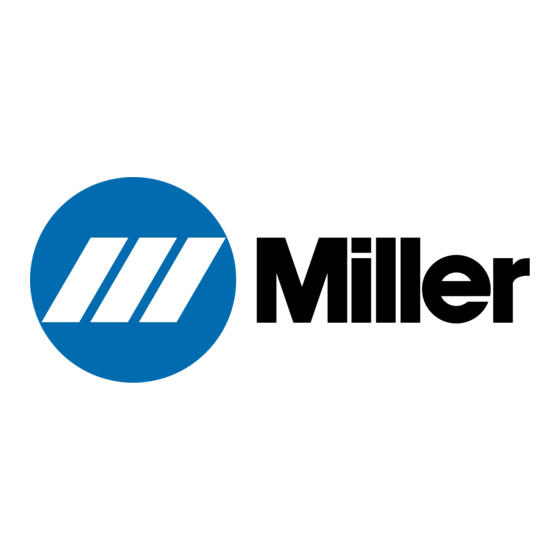Miller 900019 Manual de instalación y funcionamiento - Página 12
Navegue en línea o descargue pdf Manual de instalación y funcionamiento para Sistema de soldadura Miller 900019. Miller 900019 25 páginas.

Metal
arc
welding
with the transformer
welding
machine
depends
upon
the fundamental fact that
when
one
side of the
welding
circuit
is
attached
to
a
piece
of
steel,
a
welding
electrode connected
to
the other side and the
two
brought
into
contact,
an
arc
will be
established.
If the
arc
is
properly
controlled,
the
metal from the electrode will pass
through
the
arc
and be
deposited
on
the steeL
When the electrode is moved
along
the steel
at
the
correct
speed,
the metal will
deposit
in
a urn-
form
layer
called
a
bead.
The electrodes used in
welding
are
carefully
manufactured
to
produce
strong,
sound
welds.
They
consist of
a core
of steel
wire,
usually
called mild since it contains
a
low
(0.10. 0.14) percentage
of carbon.
Around this
core
is
applied
a
special coating
which assists
in
cre
ating
the
arc
and
at
the
same
time
protects
the
molten steel
as
it transfers
across
the
arc.
In order
to
utilize these
principles
in
metal
arc
welding,
some
means
of
controlling
the power is
essential. The power
in
a
welding
circuit is
mea
sured
by
the
voltage
and
current.
However,
the
voltage
is
governed by
the
arc
length
and in
turn
depends
on
the electrode diameter.
Therefore,
the
practical
measure
of the power,
or
heat,
is in
terms
of the
current,
generally
measured in amperes.
Obviously
a
small electrode
requires
less
current
than
a
large
one.
To
simplify
operations
the
scale
on
the front
of
the
welding
machine
is
marked
off for the various
current
values.
The
exact current
selected for
a
job depends
upon
the
size of
the
pieces
to
be welded and the
position
of
welding. Generally
a
lower
current
will
be sufficient for
welding
on
a
small
part
than
would be necessary
to weld
on
a
large piece
of
the
same
thickness.
Similarly
with
a
given
size
of electrode
a
lower
current
should
be used
on
thin metals than
on
the
heavier sections.
BUTT
FLAT POSITION W(LDS
Figure
1.1
While
it is
always
a
good policy
to
weld
on
work in
the
Nat
position,
as
shown in
Figure
1.1,
occasionally,
when
working
on
machines
or
other
large
units it will
be necessary
to
weld in
a ver
tical,
horizontal
or
overhead
position
as
shown
in
Figures
1.2, 1.3,
and
1.4,
respectively. Generally,
under these difficult conditions it
is
helpful
to
reduce the
current
from the value used
on
weld.
ing
in
the flat
position,
OVERH(AD POSITION WELDS
Filth
Figure
1.4
STRIKING THE ARC
-
RUNNING BEADS
In
learning
to
weld there
are
certain funda
mental
steps
which
must
be mastered before
one
can
attempt
to
weld
on
actual
work.
Preparatory
to
the actual
striking
of
an
arc,
it is necessary
to
insert the electrode in the
holder,
as
shown in
Figure
2.1. For
striking
an
arc,
Figure
3.1 illus
trates
what is
commonly knowing
as
the
scratch
ing technique.
In
this method
the
striking
end
of
the
electrode is
dragged
across
the work
in
a
manner
much the
same as
striking
a
match. When
the electrode touches the
work,
the
welding
cur
rent starts.
If held in this
position,
the electrode
would freeze
or
weld itself
to
the
work and
to
overcome
this,
the electrode is withdrawn from
the
work
immediately
after
contact
has
been
PRINCIPLES OF ARC WELDING
BUTT
VERTICAL
POSITION WELDS
FILLET
Figure
1.3
BUTT
(
Figure
2.1
\
//
II
BUTT
HORIZONTAL POSITION WELOS
FILLET
Figure
1.2
Figure
3.1
Page
10
